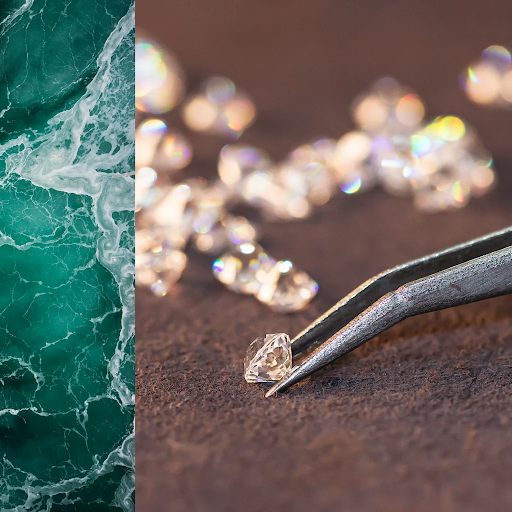


Admin
07-10-2024
In recent years, the demand for lab-grown diamonds has surged dramatically. As a modern alternative to mined diamonds, these stones blend ethical sourcing, environmental sustainability, and exceptional beauty. Lab-grown diamonds, also known as synthetic or cultured diamonds, are created using advanced technological processes that replicate the conditions under which natural diamonds form. The result is a diamond that is chemically, physically, and optically identical to its natural counterpart.
Lab-grown diamonds are produced in a controlled laboratory environment using advanced technological processes. They have the same physical, chemical, and optical properties as natural diamonds, making them indistinguishable from mined diamonds to the naked eye and even under magnification.
In 1797, scientists made the groundbreaking discovery that diamonds consist of pure carbon, sparking a race to create the first synthetic diamond. Throughout the 19th century, many attempted to recreate the conditions necessary for diamond formation in a laboratory setting, but despite numerous claims of success, scientists could not replicate these experiments.
General Electric (GE) successfully created the first proven synthetic diamonds in 1954 as part of "Project Superpressure." This project, which began in the 1940s but was delayed by World War II, involved extensive experimentation with various methods, temperatures, and pressures to produce diamonds from carbon. Using a high-pressure belt press, the scientists subjected small seed crystals to temperatures of 1,600º C (2,912º F) and pressures of 100,000 atmospheres. In this process, they dissolved graphite — another mineral composed of pure carbon — in metals such as iron, nickel, and cobalt to expedite the conversion of graphite to diamond.
When the resulting material proved harder than the scientists' cutting tools, they realized they had succeeded. With a Mohs hardness rating of 10, diamonds are famously capable of scratching and destroying metal tools. Subsequently, the scientists confirmed that they had indeed produced diamonds. The discovery was credited to a team of scientists, including Herbert Strong and Howard Tracy Hall.
Lab-grown diamonds are created using two primary methods: High-Pressure High Temperature (HPHT) and Chemical Vapor Deposition (CVD). Even though both methods reaps somewhat similar results, understanding the aspects might come in handy when you want to buy lab grown diamonds:
Lab-grown diamonds have a significantly lower environmental impact than mined diamonds. Traditional diamond mining can lead to deforestation, soil erosion, and biodiversity loss. In contrast, lab-grown diamonds require less land and water and produce fewer carbon emissions, making them a more sustainable choice.
One of the significant ethical advantages of lab-grown diamonds is that they are free from the concerns associated with conflict diamonds (also known as blood diamonds). These are diamonds mined in war zones and sold to finance armed conflict against governments. Consumers can ensure their purchase does not fund violence or human rights abuses by choosing lab-grown diamonds.
Lab-grown diamond jewelry is generally less expensive than its natural counterparts in the USA and globally. The cost savings come from the streamlined production process and the absence of the extensive mining operations required for natural diamonds. This allows consumers to purchase larger or higher-quality diamonds for the same price as a smaller or lower-quality mined diamond.
When buying lab-grown diamonds, consumers can choose between online and in-store purchases. At Lab Grown Diamonds USA LLC, we offer a wider selection and lower prices due to reduced overhead costs. Our in-store purchases, on the other hand, allow you to view the diamonds in person and receive immediate assistance from our sales professionals.
When purchasing lab-grown diamonds, consider the following factors:
Buying lab-grown diamonds wholesale can offer significant cost savings, especially for retailers, jewelers, and designers. Wholesale purchases typically involve bulk buying, which reduces the per-carat cost of the diamonds.
To find reliable wholesalers, consider the following tips:
Lab-grown diamond jewelry comes in various styles and designs, catering to diverse tastes and preferences. Popular styles include classic solitaire rings, halo settings, and three-stone rings. Lab-grown diamonds are also used in earrings, necklaces, bracelets, and custom pieces.
Many jewelers offer custom-made jewelry options, allowing customers to design unique pieces that reflect their style. Choose your favorite diamond cut from our collection and pair it with the setting, metal type, and other design elements to create a one-of-a-kind piece.
Lab-grown diamond jewelry is available from various retailers, both online and in-store. Lab Grown Diamonds USA LLC offers a wide range of lab-grown diamond jewelry and fancy colored and melee lab-grown diamonds.
Ongoing technological advancements are improving the quality and reducing the cost of lab-grown diamonds. Innovations in HPHT and CVD methods continue to enhance the efficiency and scalability of diamond production.
The market for lab-grown diamonds is expected to grow significantly in the coming years. Increasing consumer awareness of environmental and ethical issues, combined with the cost advantages of lab-grown diamonds, will likely drive demand.
As technology advances, the environmental impact of producing lab-grown diamonds is expected to decrease further. This makes lab-grown diamonds an increasingly attractive option for environmentally conscious consumers.
Yes, lab-grown diamonds are natural diamonds. They have the same physical, chemical, and optical properties as natural diamonds.
Lab-grown diamonds are often considered better due to their ethical sourcing, lower environmental impact, and affordability. They offer the same beauty and durability as natural diamonds without the associated ethical and environmental concerns.
LGD USA LLC is one of the premium diamond wholesalers in New York, they offer a wide range of melee diamonds, fancy colored diamonds, lab diamond jewelry and so much more.
Yes, lab-grown diamonds are as hard as natural diamonds. Both types score a 10 on the Mohs hardness scale, making them the hardest known material.
